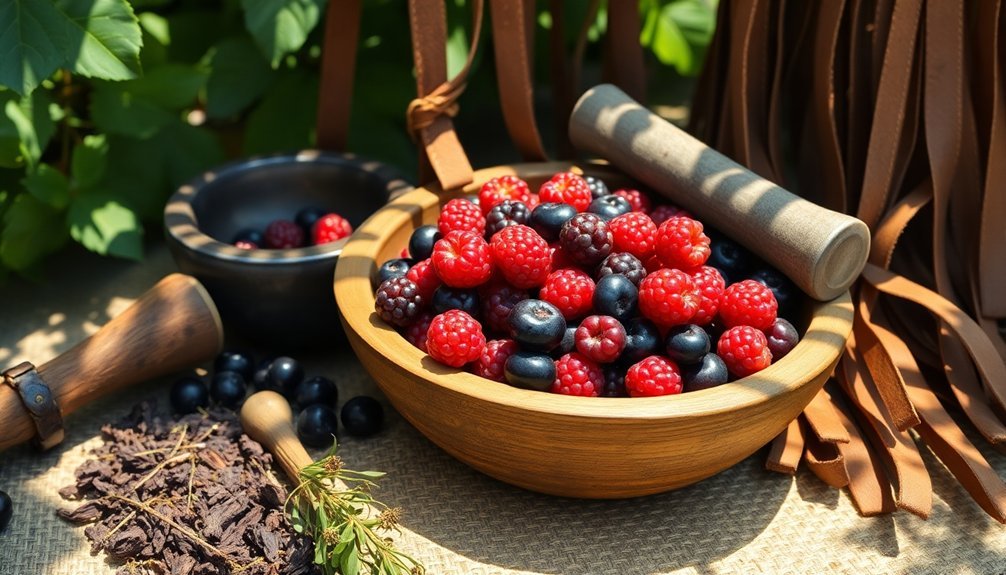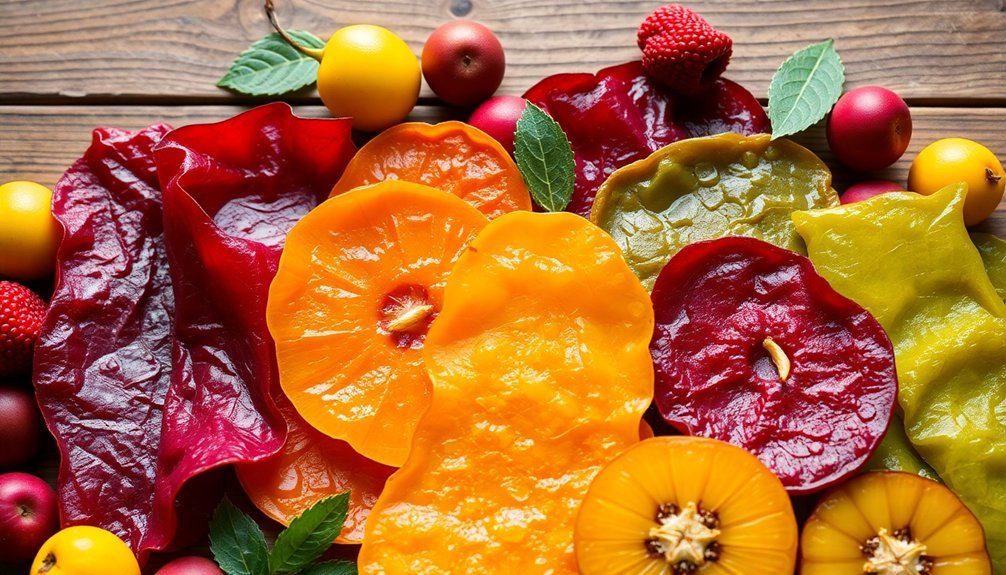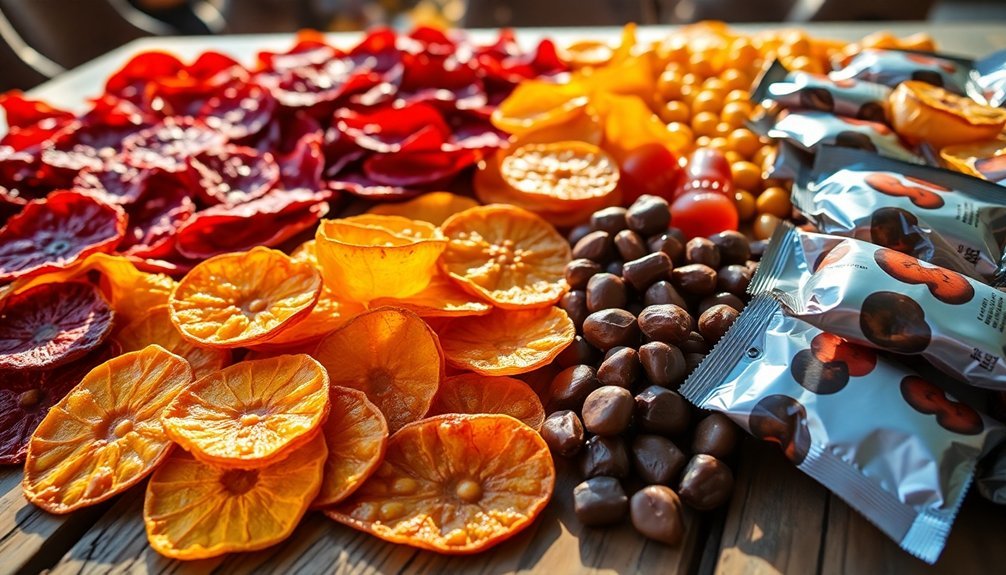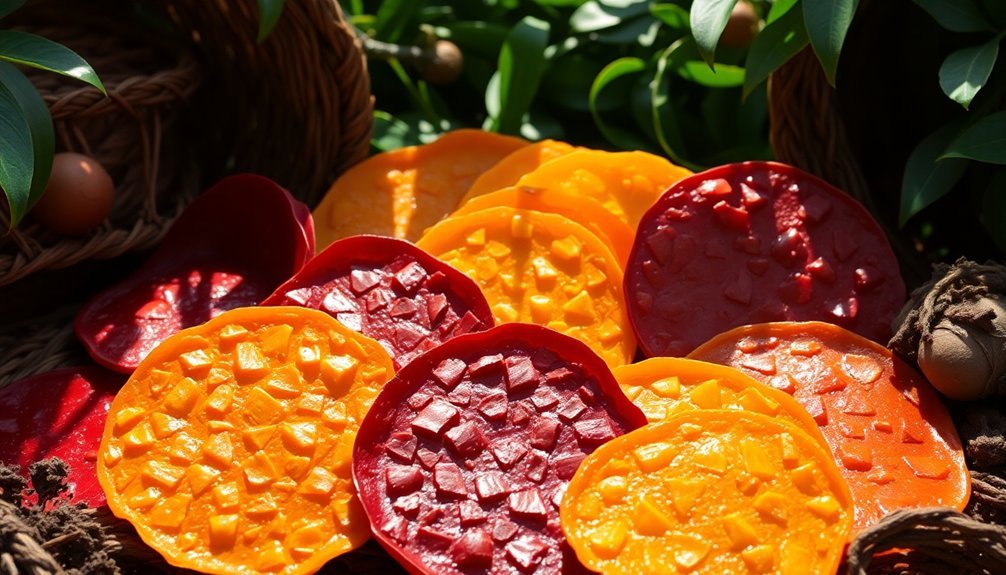Indigenous fruit leather lasts for generations because it uses traditional techniques and natural preservation methods. You start with high-quality, ripe fruits and employ dehydration methods like sun drying or using natural ingredients like lemon juice to keep it fresh. These methods respect the ecosystem and maintain the flavors and nutrients that modern techniques often lose. Cultural practices pass this knowledge down, reinforcing the connection to the land and its resources. Plus, the emphasis on natural ingredients enhances both taste and nutrition. You'll find that exploring the details behind these methods reveals even more about this delicious and enduring tradition.
Historical Significance of Fruit Leather

Historically, people in the Middle East frequently experimented with preserving fresh fruit by pureeing, cooking, and drying it into what we now know as fruit leather. Among the earliest flavors was apricot, with references found in ancient cookbooks and Armenian recipes, where it was known as *bastegh*. The process involved pouring cooked and pureed fruit onto muslin sheets and drying them under the sun, creating a method that's been cherished for generations.
Once dried, they stored the fruit leather in glass jars, cut into convenient shapes. Culturally, variations of fruit leather emerged, highlighting regional flavors and culinary traditions. For instance, Tklapi, a traditional Georgian fruit leather, holds a significant place in Georgian cuisine, while fig Tklapi in Abkhazia served both as food and a wound treatment.
Indigenous fruits, like marula in Southern Africa, contribute to local food security by transforming into fruit leathers. This preservation method not only extends the fruit's shelf life but also maintains its nutritional value, making it an important resource. Additionally, the primary ingredients of modern fruit leathers often include fruit puree, which enhances the flavor and texture of the product.
Traditional Dehydrating Methods
There are several effective traditional methods for dehydrating fruit leather, each offering its unique benefits. You can choose from using an electric dehydrator, an oven, or even the sun, depending on your preference and available resources.
| Method | Key Points |
|---|---|
| Dehydrator | Set at 140°F, dry for 6-10 hours, test for dryness by checking the center. Peel while warm. |
| Oven | Lowest setting under 200°F, dry for 6-18 hours, guarantee even layers, test for dryness similarly. |
| Sun Drying | Spread thinly, dry for 1-2 days, bring inside at night, check for dryness as above. |
Regardless of the method you choose, maintaining consistent drying temperatures is essential. Additionally, it is important to note that drying times can vary depending on the thickness of the fruit puree and the method of drying. Make certain to avoid pouring the puree too close to the edges of the trays, as this can lead to uneven drying. Remember, larger batches will take longer to dry than smaller ones. Once dried, your fruit leather should be translucent and slightly tacky. Store it in a cool, dry, dark place to guarantee it lasts for generations.
Ingredient Selection and Preparation

When you're making fruit leather, selecting high-quality, ripe fruits is essential for the best flavor. You'll want to puree your chosen fruits smoothly and consider adding ingredients like lemon juice or honey to enhance the taste and preservation. Additionally, using a meat thermometer to monitor the oven temperature is crucial for achieving the right texture. With the right techniques, you'll set yourself up for a delicious and satisfying treat.
Choosing Quality Fruits
Choosing quality fruits is essential for creating delicious and nutritious fruit leather. Start with fresh, frozen, or drained canned fruits rated as "excellent" or "good." Opt for fruits like apples, apricots, berries, cherries, nectarines, peaches, pears, pineapple, plums, and strawberries.
To achieve the best texture, combine high-pectin fruits, like apples, with low-pectin fruits, such as peaches. Fiber-rich fruits, like berries and bananas, enhance health benefits as well.
When preparing your fruits, wash them in cool water and remove any peels, seeds, and stems. Cut the fruit into chunks before pureeing. Typically, you'll need about 2 cups of fruit for each 13" x 15" tray of fruit leather. If you're using canned or frozen fruit, remember to save the liquid for adjusting consistency later.
Don't overlook bruised fruit or leftover pulp from juicing; they can still be valuable ingredients.
Pureeing Techniques
To create the perfect fruit leather, selecting and preparing your ingredients is essential. Start by choosing ripe or slightly over-ripe fruit for the best flavor and texture.
Make sure to sort and thoroughly rinse the fruit to remove any dirt or debris. Don't forget to remove any blemished or damaged parts to guarantee quality.
Depending on the fruit, peeling might be necessary—tough-skinned fruits should always be peeled, while soft-skinned fruits can be peeled for a smoother leather. Remember to pit, core, and destem the fruit as needed before pureeing.
Here are some key steps to take into account:
- Aim for a puree consistency similar to applesauce for best drying results.
- Use a blender or food processor for smooth textures, especially with strawberries or blackberries.
- Strain the mixture through a fine mesh strainer to remove seeds, if necessary.
- Avoid using a blender for fruits like raspberries to prevent seed damage—opt for a sieve instead.
- Mix different fruits for unique flavor combinations, enhancing your leather's taste.
Adding Preservative Ingredients
Adding preservative ingredients is essential for enhancing the flavor and longevity of your fruit leather. To prevent darkening, add 2 teaspoons of lemon juice or 1/8 teaspoon of ascorbic acid for every 2 cups of light-colored fruit. This step helps maintain the vibrant color and freshness, especially for fruits prone to browning. You can use either ingredient interchangeably based on what's available.
Sweeteners also play a role in preservation. Consider adding corn syrup or honey, as they help prevent crystallization and are ideal for long-term storage. If you're looking for immediate enjoyment, sugar works well. For lower-calorie options, saccharin-based sweeteners can reduce tartness.
Pectin is vital too; it creates a thick, pliable texture. High-pectin fruits like apples can be combined with low-pectin varieties for the best results. If you're avoiding sugar, Pomona's Pectin is a great option that allows you to scale up your recipe without losing quality.
Finally, consider adding applesauce or white grape juice concentrate for flavor and preservation. Avoid fruits like grapefruit, which can turn bitter when dried. Optional spices can enhance flavor without affecting preservation.
Role of Natural Preservatives
Preserving the vibrant flavors and colors of fruit leather relies heavily on natural preservatives that maintain its quality. By incorporating these ingredients, you guarantee your fruit leather remains appealing and delicious for longer periods.
Here are some key roles that natural preservatives play:
- Prevention of Darkening: Adding lemon juice or ascorbic acid helps prevent enzymatic browning in light-colored fruits like apples and peaches.
- Control of Sugar Crystallization: Using corn syrup or honey keeps sugar crystals at bay, contributing to a smoother texture.
- Pectin as a Natural Thickener: High-pectin fruits aid in creating a thick, chewy leather, enhancing both texture and structure.
- Health Benefits: Pectin adds insoluble fiber, making your fruit leather not only tasty but nutritious as well.
- Proper Storage: Keeping your fruit leather in a cool, dry, dark place can extend its shelf life considerably.
Techniques Passed Through Generations

You'll find that the techniques for making fruit leather have been passed down through generations, each family adding their unique touch.
These time-honored methods prioritize natural ingredients, reflecting a deep appreciation for the land and its offerings.
As you explore these traditions, you'll uncover the cultural significance behind each step, connecting you to a rich heritage.
Time-Honored Methods
For generations, families have passed down the art of making indigenous fruit leather, relying on time-honored techniques that transform ripe fruits into delicious, chewy snacks. You start by selecting ripe or slightly overripe fruit, ensuring the best flavor.
Next, wash the fruit in cool water and remove the peel, seeds, and stem. Cut the fruit into chunks and puree it until smooth, aiming for an applesauce-like consistency.
Here are some essential steps to follow:
- Use 2 cups of pureed fruit for each 13" x 15" sheet of fruit leather.
- Add 2 teaspoons of lemon juice or 1/8 teaspoon of ascorbic acid to prevent darkening.
- Dry the leather in an electric dehydrator at 140°F or an oven set to the lowest temperature with the door slightly open.
- Monitor the drying process for 4 to 10 hours, ensuring no indentation remains when testing for dryness.
- Store the cooled leather properly in a cool, dark place, ideally in the freezer for longer preservation.
Natural Ingredients Emphasis
Throughout generations, families have honed their craft of making fruit leather by emphasizing the use of natural ingredients. By selecting fresh and ripe fruits, you guarantee the best flavor and texture. Ripe fruits bring out the natural sweetness, and washing them in cool water keeps them clean. Here's a quick look at key elements you'll want to reflect on:
| Ingredient Type | Benefits | Usage Tips |
|---|---|---|
| Fresh Fruit | Enhances flavor and sweetness | Use 2 cups for a standard batch |
| Pectin & Fiber | Provides chewiness and durability | Combine high-pectin fruits for best results |
| Natural Sweeteners | Avoids crystallization, maintains integrity | Use honey or corn syrup sparingly |
You'll also want to avoid preservatives by using methods like adding lemon juice to prevent darkening. Spices like cinnamon can enhance flavor naturally. Incorporating applesauce can help with pliability and taste, guaranteeing your fruit leather remains delicious and nutritious. By focusing on these natural ingredients, you're not just making a treat; you're continuing a tradition that celebrates the earth's bounty.
Cultural Significance and Traditions
Cultural significance runs deep in the traditions of making fruit leather, particularly among Indigenous communities. This practice isn't just about creating a tasty snack; it's a profound expression of respect for nature and the ties that bind families and communities.
Berries play an essential role in Coast Salish culture, serving as a key ingredient in ceremonies and gatherings.
Here are some ways these traditions are passed down:
- Harvesting berries fosters respect for the ecosystem's balance.
- Families work together, teaching resilience and interconnectedness.
- Special tools like cedar bentwood boxes and baskets are crucial.
- Techniques for pureeing and drying berries have been refined over generations.
- Elders share knowledge about the cultural and medicinal uses of berries.
Importance of Storage Conditions
Proper storage conditions are vital for preserving the quality and safety of indigenous fruit leather. For short-term preservation, you can store it at room temperature for 1-2 months, but refrigeration extends its shelf life to 6-12 months.
If you want to maximize preservation, freezing is the best option, keeping it fresh for up to a year. Aim for ideal storage temperatures between 60°F and 70°F (15°C to 21°C) at room temperature.
When freezing, wrap the leather tightly in plastic wrap and place it in a freezer bag to prevent freezer burn.
Humidity plays a significant role, so keep moisture levels low to avoid mold and texture changes. Store your fruit leather in airtight containers or sealed plastic bags, and avoid high humidity or direct sunlight.
Always check it periodically for signs of spoilage like mold or off-odors.
Packaging integrity is important, too. Use clean, dry hands and utensils to handle fruit leather and keep it in intact packaging.
Cutting it into portions can minimize exposure when you access it. Following these storage practices guarantees your indigenous fruit leather remains safe and delicious for generations.
Enhancing Flavor and Texture

To elevate the taste and mouthfeel of your indigenous fruit leather, you can explore various ingredients and techniques that enhance both flavor and texture.
Start by experimenting with sweeteners like honey or corn syrup, which not only add sweetness but also prevent crystal formation, keeping your leather fresh longer. Lemon juice is a fantastic addition, offering a tangy flavor and preserving the vibrant color of your fruits.
Consider these tips to enhance your fruit leather:
- Mix different fruit purees for unique flavors and textures.
- Use spices like cinnamon or flavorings like mint to add depth.
- Adjust the puree consistency to resemble thick applesauce for even drying.
- Aim for a uniform thickness of 1/8 to 1/4 inch to guarantee consistent texture.
- Monitor drying times closely, whether you're using a dehydrator, oven, or the sun.
Benefits of Sun Drying
Sun drying your fruit leather is a natural preservation method that enhances its unique flavor while saving energy.
You get to harness the power of the sun, making it an eco-friendly choice for food preservation.
Plus, it's a simple process that doesn't require fancy equipment or electricity.
Natural Preservation Method
Harnessing the power of the sun, sun drying offers an effective and environmentally friendly way to preserve fruits and vegetables. By utilizing sunlight, this method eliminates the need for electricity, making it ideal for off-grid or low-resource environments. You won't incur any costs during the drying process, which also reduces reliance on electrical appliances.
Here are some benefits of sun drying:
- Longevity: Properly dried fruits can last up to five years, while dried vegetables can last a decade or more.
- Safety: The low moisture and pH levels in dried fruits reduce the risk of bacterial growth, minimizing food-borne illnesses.
- Natural Preservation: Sun drying harnesses natural antimicrobial compounds that help keep your food safe and tasty.
- Cultural Significance: This traditional method is often passed down through generations, preserving cultural heritage and community practices.
- Sustainability: By relying on sunlight, you contribute to an environmentally friendly method of food preservation.
Incorporating sun-dried fruits and vegetables into your diet not only enhances flavor but also supports sustainable living practices. Embrace this natural preservation method to enjoy long-lasting, nutritious foods!
Unique Flavor Development
The magic of sun drying lies in its ability to intensify the natural flavors of fruits and vegetables, transforming them into vibrant, delicious ingredients. When you sun-dry foods, you preserve and concentrate their inherent tastes, making them richer and more vibrant. Ever tried sun-dried tomatoes? They develop a deep, concentrated flavor that elevates any dish.
This method not only enhances flavors but also retains more nutrients than high-heat drying methods. The low-temperature process helps keep essential vitamins and minerals intact, ensuring that your dried fruits and vegetables remain nutritionally valuable.
Sun drying naturally reduces moisture content, typically leaving 15-20% moisture, which inhibits microbial growth. This means your sun-dried foods aren't only flavorful but also safer and longer-lasting.
You'll notice that the variability in drying time depends on the type of food, thickness, and weather conditions. Fruits may take 2-4 days, while vegetables can require 3-5 days. Ideal conditions include temperatures above 85°F (29°C) and low humidity.
With steady airflow, the sun drying process becomes even more effective, resulting in unique flavors that you can savor for generations.
Sustainable Energy Source
Utilizing natural sunlight for drying fruits and vegetables offers an eco-friendly solution that reduces reliance on electricity and fossil fuels. By harnessing the power of the sun, you not only conserve energy but also contribute to a healthier planet.
Sun drying is a sustainable method that provides several benefits:
- No energy costs: You won't need to pay for electricity or fuel.
- Minimal environmental impact: It doesn't produce greenhouse gas emissions.
- Accessibility: You can do it in areas lacking electrical power.
- Supports off-grid living: It promotes self-sufficiency and independence.
- Cost-effective: You can save money while preserving food naturally.
This method is especially valuable for those looking to embrace a more sustainable lifestyle. By choosing sun drying, you're making a conscious decision to protect the environment while enjoying delicious, long-lasting fruit leather.
With the right conditions—like direct sunlight and proper equipment—you'll find that sun drying isn't only practical but also an enriching experience that connects you with traditional food preservation methods.
Comparison With Modern Techniques

When you compare indigenous fruit leather techniques with modern methods, the differences become strikingly clear.
Indigenous methods rely on native fruits, often using no added sugars or preservatives. You might find that fruits are mashed or pureed manually, with seeds and skins left in for extra nutrition. Drying is typically done through sun or air drying, which takes longer but preserves the fruit's natural properties.
In contrast, modern techniques often utilize a variety of fruits, including exotic options, and involve baking to soften them before pureeing. You'd likely notice the use of electric dehydrators, allowing for precise temperature control and quicker drying times.
While modern methods offer convenience, they often involve added sugars and preservatives, which can alter the natural flavor.
Storage also differs considerably; indigenous fruit leather is often kept in natural materials like woven baskets, while modern versions use plastic wraps or vacuum-sealed bags.
Although both methods can yield durable fruit leather, the indigenous approach emphasizes natural preservation, resulting in a product that can last for years, retaining its nutritional value.
In contrast, modern fruit leather generally has a shorter shelf life, dependent on storage conditions.
Cultural Impact on Preservation
Cultural practices play an important role in the preservation of indigenous fruit leather, weaving together community ties and nutritional knowledge. For you, participating in berry harvesting isn't just about gathering food; it's a family and community activity that builds resilience and interconnectedness with nature.
As you engage in these traditions, you foster social bonds and guarantee cultural continuity.
Consider the following aspects of this rich heritage:
- Berries hold significant cultural and nutritional value, especially among the Coast Salish people.
- The process of making fruit leather is passed down through generations, preserving crucial cultural traditions.
- Traditional preservation methods, like using cedar boxes, reflect deep respect for the ecosystem.
- Forest gardens demonstrate a sophisticated understanding of sustainable food production.
- The act of soaking dried berry cakes before consumption connects you to ancient practices.
These cultural connections not only enhance the quality of the food but also reinforce a sense of belonging.
Frequently Asked Questions
What Types of Fruits Are Traditionally Used for Fruit Leather?
When making fruit leather, you'll often use traditional fruits like apples, apricots, bananas, and berries. Experiment with combinations, like mixed blueberries and raspberries or coconut mango, for unique flavors that excite your taste buds.
How Does Climate Affect the Drying Process of Fruit Leather?
Climate considerably affects the drying process of fruit leather. High humidity slows drying, while low humidity speeds it up. You should avoid rainy weather, ensuring proper air circulation and temperature for ideal results.
Can Fruit Leather Be Made Without Added Sweeteners?
Yes, you can make fruit leather without added sweeteners. The natural sweetness from ripe fruits like strawberries or grapes is usually enough. Just puree the fruit, dry it, and enjoy your delicious, healthy snack!
What Are the Common Mistakes When Making Fruit Leather?
When making fruit leather, you often overlook equipment usage, drying temperatures, and puree consistency. Don't forget to check for even drying, store properly, and handle with clean hands to avoid spoilage and achieve delicious results.
How Can You Tell if Fruit Leather Has Gone Bad?
You can tell fruit leather's gone bad by checking for mold, discoloration, or unusual texture. If it smells sour or has a sticky surface, it's best to throw it away to avoid health risks.
In Summary
To summarize, the enduring legacy of indigenous fruit leather lies in its rich history and traditional methods. By selecting the right ingredients and employing natural preservatives, these techniques have been passed down through generations, enhancing flavor and texture. The benefits of sun drying not only preserve the fruit but also celebrate cultural heritage. Embracing these time-honored practices keeps the spirit of indigenous food traditions alive, ensuring that the art of fruit leather making thrives for years to come.





Leave a Reply